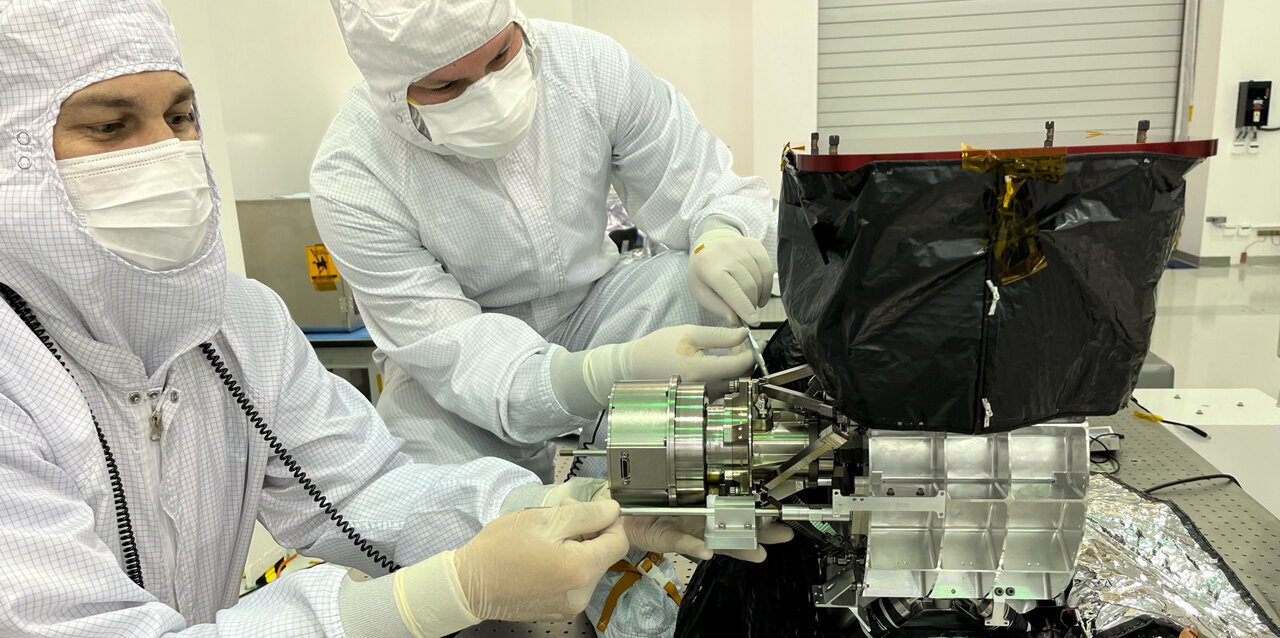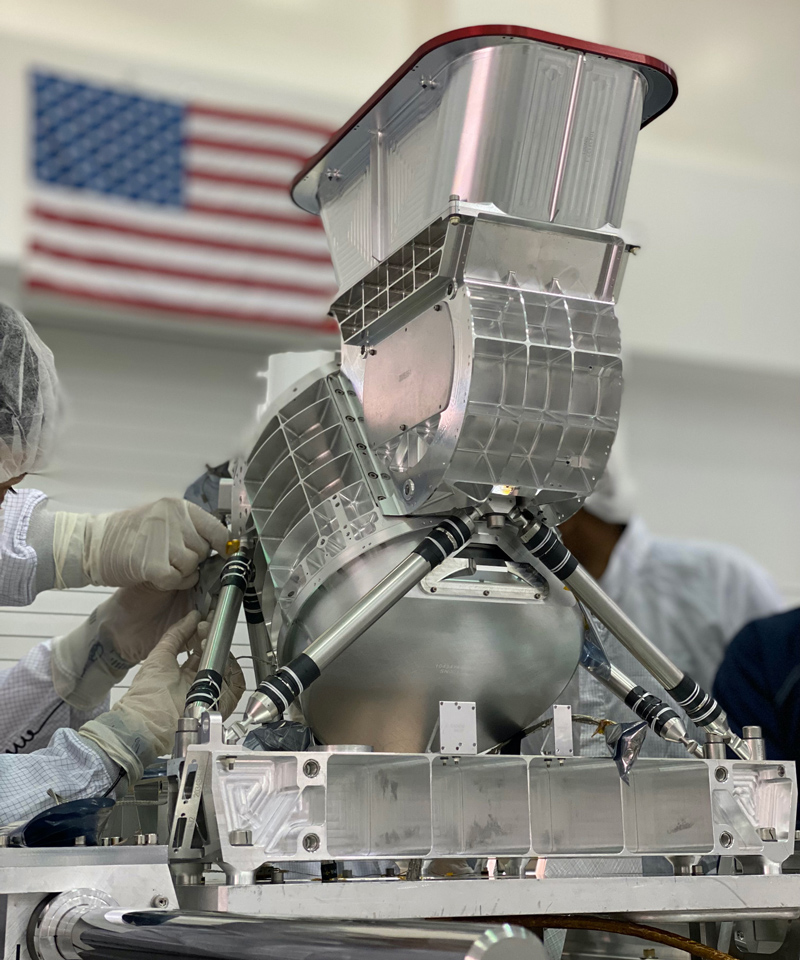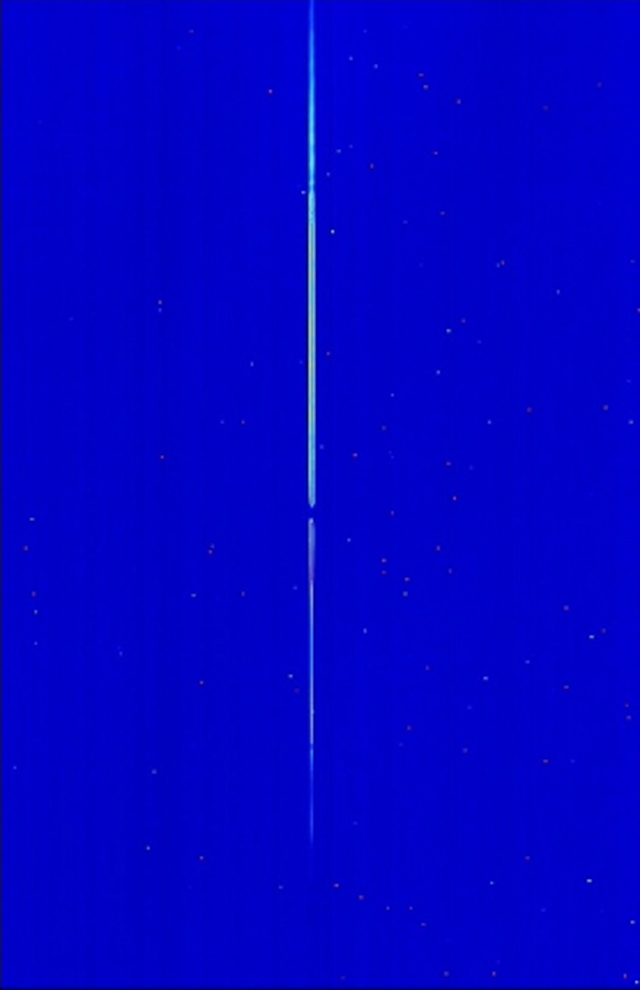Mission Updates | April 12, 2022
Mission Dispatch: Imaging Spectrometer's First Light

In a clean room at NASA’s Jet Propulsion Laboratory, engineering flight technicians Sam Reyes and Duncan Cogswell install the flight scanner into the MISE instrument. The scanner was provided by the Johns Hopkins University Applied Physics Laboratory, in Maryland. Credit: NASA/JPL-Caltech
Europa Clipper will carry an intricate array of instruments to study Jupiter’s moon Europa, including an imaging spectrometer that will analyze infrared light reflected from the moon to look for surface materials, including sulfates, carbonates, and organic compounds. The instrument will map Europa’s surface composition in detail to help scientists understand both Europa’s geologic history and the moon’s ocean.
Europa Clipper’s imaging spectrometer, known as MISE (Mapping Imaging Spectrometer for Europa), is built on knowledge gleaned from flying similar instruments on previous space missions. Using that foundation, a team at NASA’s Jet Propulsion Laboratory (JPL) in partnership with the Johns Hopkins University Applied Physics Laboratory (APL) has been hard at work designing, building, and testing MISE. The team recently achieved a milestone for any telescope: first light. For MISE, this event was the first time that light from a test source in a laboratory traveled through the collection of mirrors, lenses, and detectors in the actual hardware that will fly to Europa in a few short years.
A Legacy of Imaging Spectrometers

Most of the MISE instrument – including its housing, mirrors, lenses, detectors, shielding, and computer – is custom manufactured. Components come from different institutions, including JPL and APL. However, while the parts may be custom-designed, MISE principal investigator Dr. Diana Blaney notes, “The science of our instrument relies on the science results from the Galileo and Cassini missions’ imaging spectrometers.”
Originally developed by NASA in the 1970s to study Earth from space, imaging spectrometers have grown to play important roles in exploration throughout the solar system. Galileo and Cassini, the first spacecraft to orbit Jupiter and Saturn, respectively, each carried an imaging spectrometer to survey their destination planets, moons, and rings. Especially relevant to Europa Clipper, Galileo provided the most in-depth information about Europa to date, and Cassini revealed that Saturn’s moon Enceladus is an ocean world, just like Europa.
Europa Clipper’s imaging spectrometer also draws on the legacy of the JPL-led M3 (Moon Mineralogy Mapper) instrument on India's Chandrayaan-1 mission, the CRISM (Compact Reconnaissance Imaging Spectrometer for Mars) instrument on NASA’s Mars Reconnaissance Orbiter, and another JPL spectrometer, EMIT (Earth Surface Mineral Dust Source Investigation), that will be installed on the International Space Station. EMIT will be the first instrument to comprehensively measure the mineral composition of arid regions on Earth that produce dust.
MISE benefits from this legacy. The engineering team that built the optics and thermal control system for M3, as well as the scanner and electronics for CRISM, also developed MISE. They are familiar with the challenges of building, calibrating, and operating imaging spectrometers for deep space. And they applied that knowledge when developing MISE for the challenging environment around Europa, where particle radiation is much higher and sunlight much weaker than it is in the inner solar system.
Achieving First Light

During the MISE first-light testing, JPL integration and test lead Dr. Danielle Nuding and her colleagues watched through a window into the clean room. Inside was the team’s optics lead Hong Tang, wearing a white, full-body protective gown and mask, known as a “bunny suit,” to avoid contaminating the instrument. Only the optics lead could see the computer screen displaying the test results. Nuding and her colleagues outside would not know how things were going until the optics lead reported it to them.
“Even though he had a mask on, we could still see that he was smiling from ear to ear,” Nuding said. “It was an incredible moment to experience.”
MISE measures multiple wavelengths of infrared light in each location, collecting only one line of pixels at a time (that is why the instrument’s successful first light image shows only one line of spectra). During operation, MISE will capture line after line, each adjacent to the previous one, until the instrument has recorded 300 lines. The 300 lines are then combined to make a single image containing the signatures of the atoms and molecules that are present. This technique is known as a push-broom observation, assembled in a manner somewhat analogous to that of a moving scanner line in a traditional photocopier. MISE will repeat this operation during the spacecraft’s flybys of Europa to provide scientists with a map of the composition of Europa’s surface.
But MISE is, of course, not yet at the finish line.
“First light is just the beginning of many activities to verify that the instrument is built and functioning correctly before it can be integrated with the spacecraft,” said Annette Sahakian, JPL instrument manager for MISE. “There are a few more pieces to integrate before the instrument is fully assembled, and every time a piece is added, the instrument goes through rigorous testing to verify it’s working and maintaining alignment and focus. Then the next piece is integrated.” There are many exciting milestones ahead as MISE makes its way to Europa.



